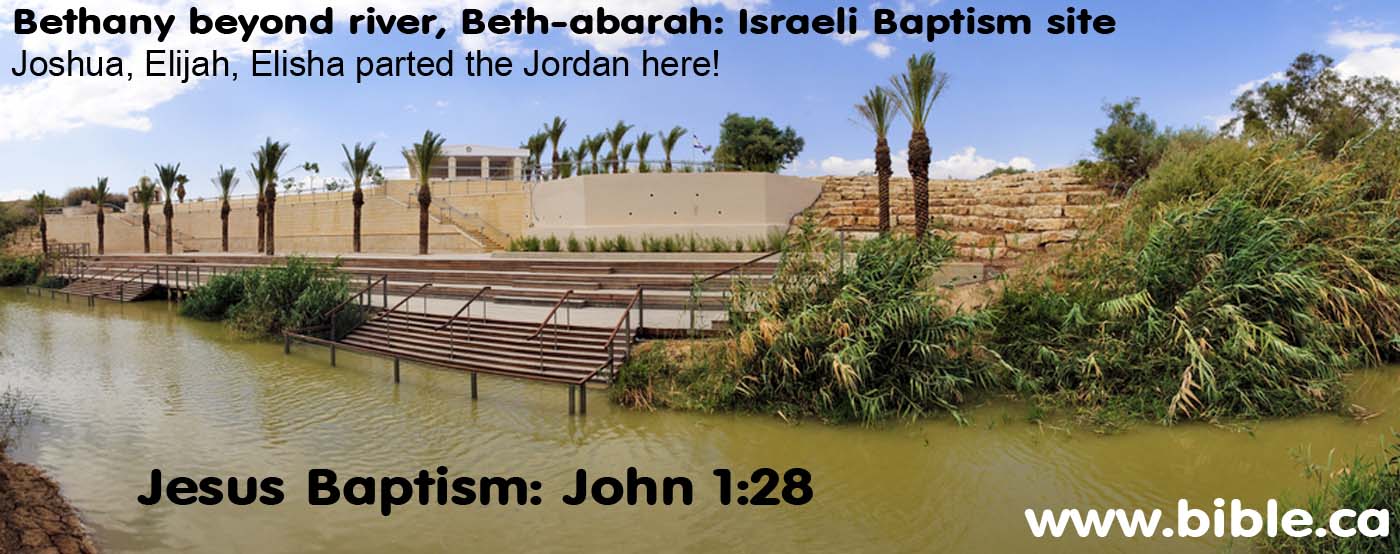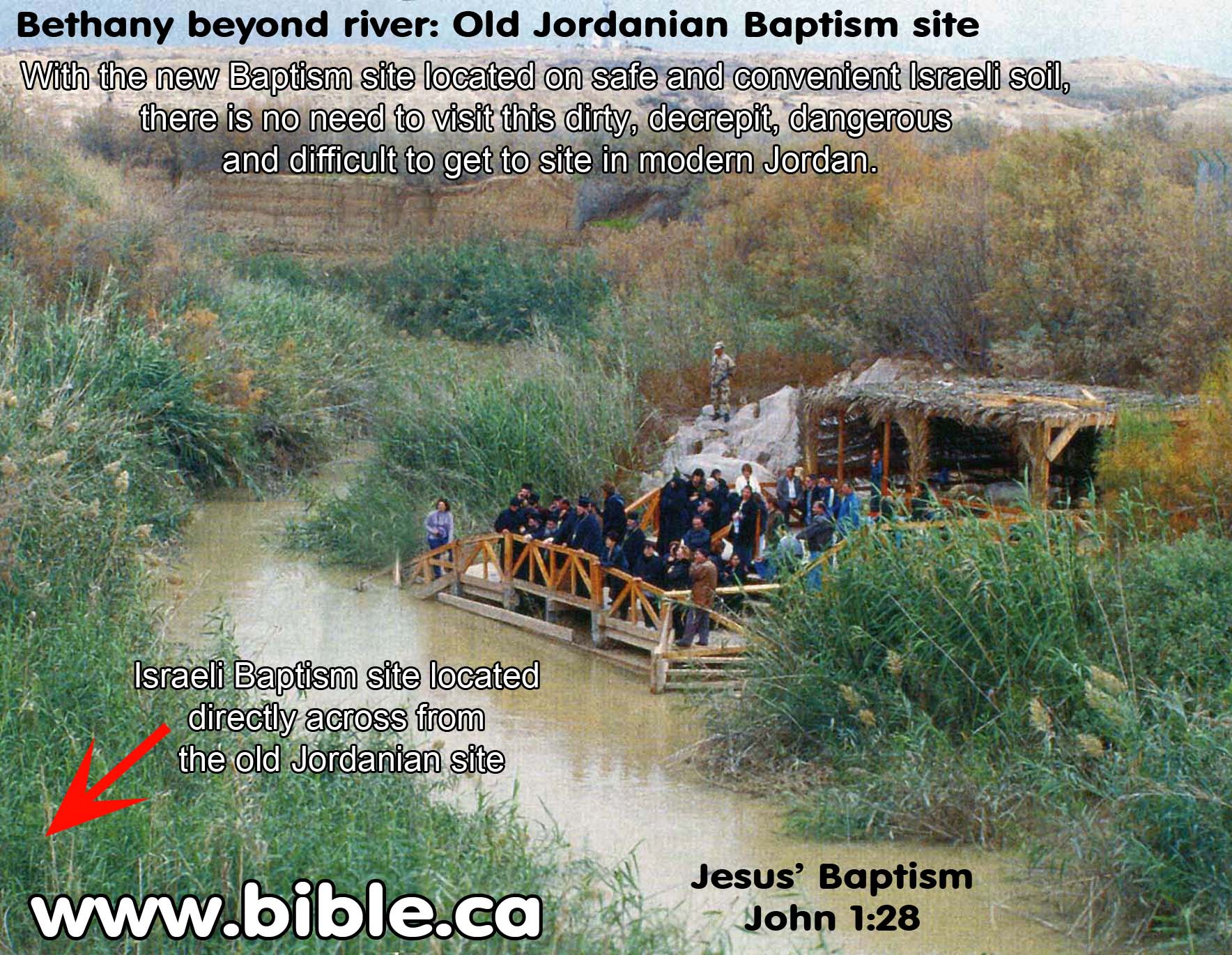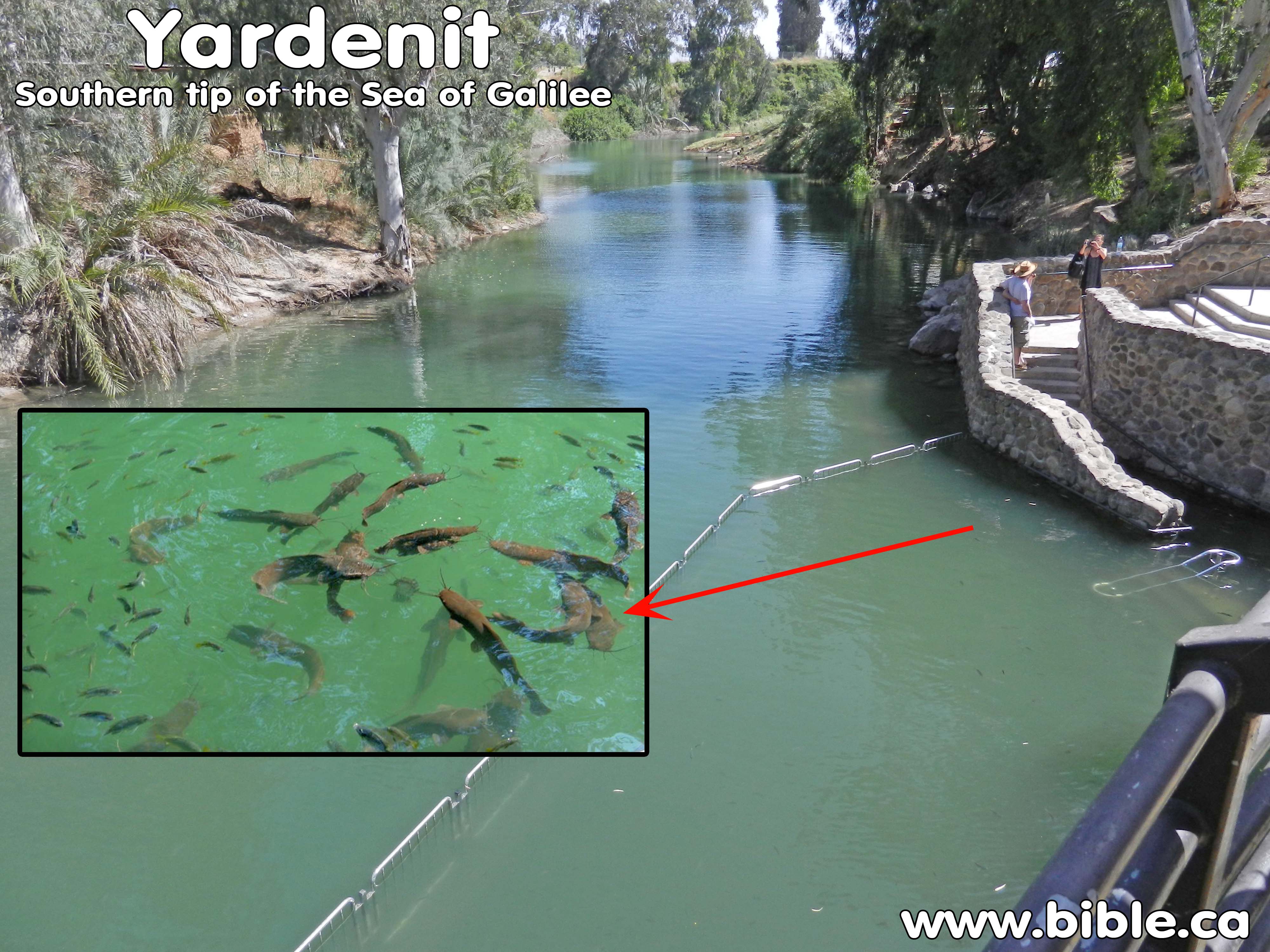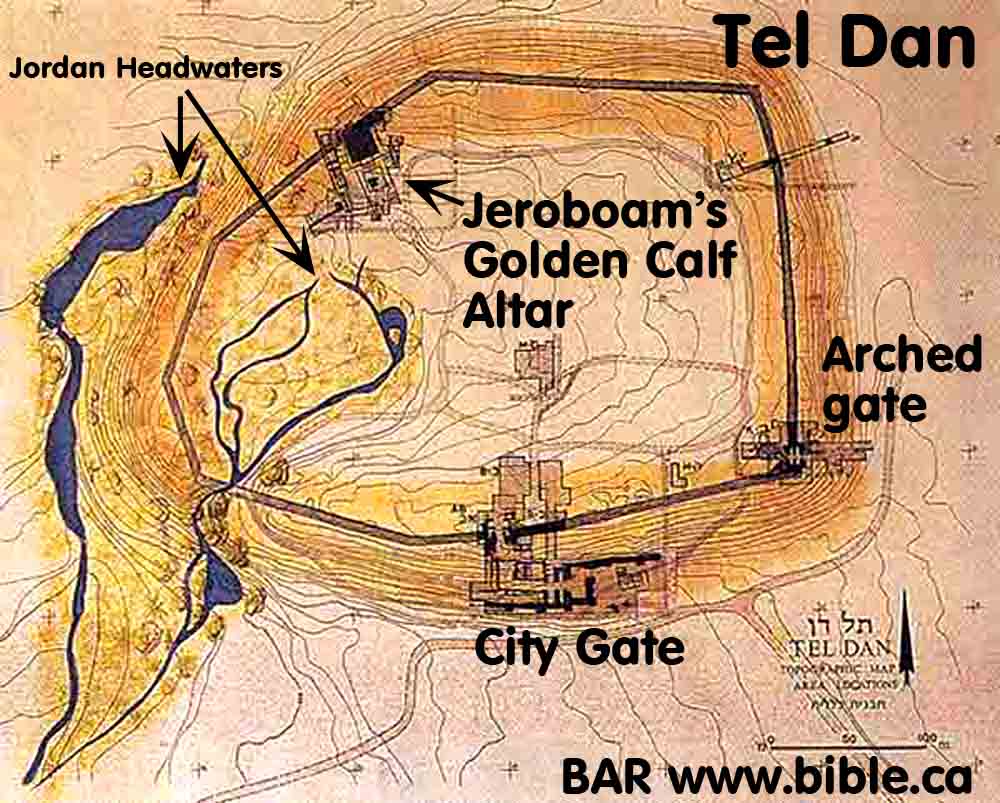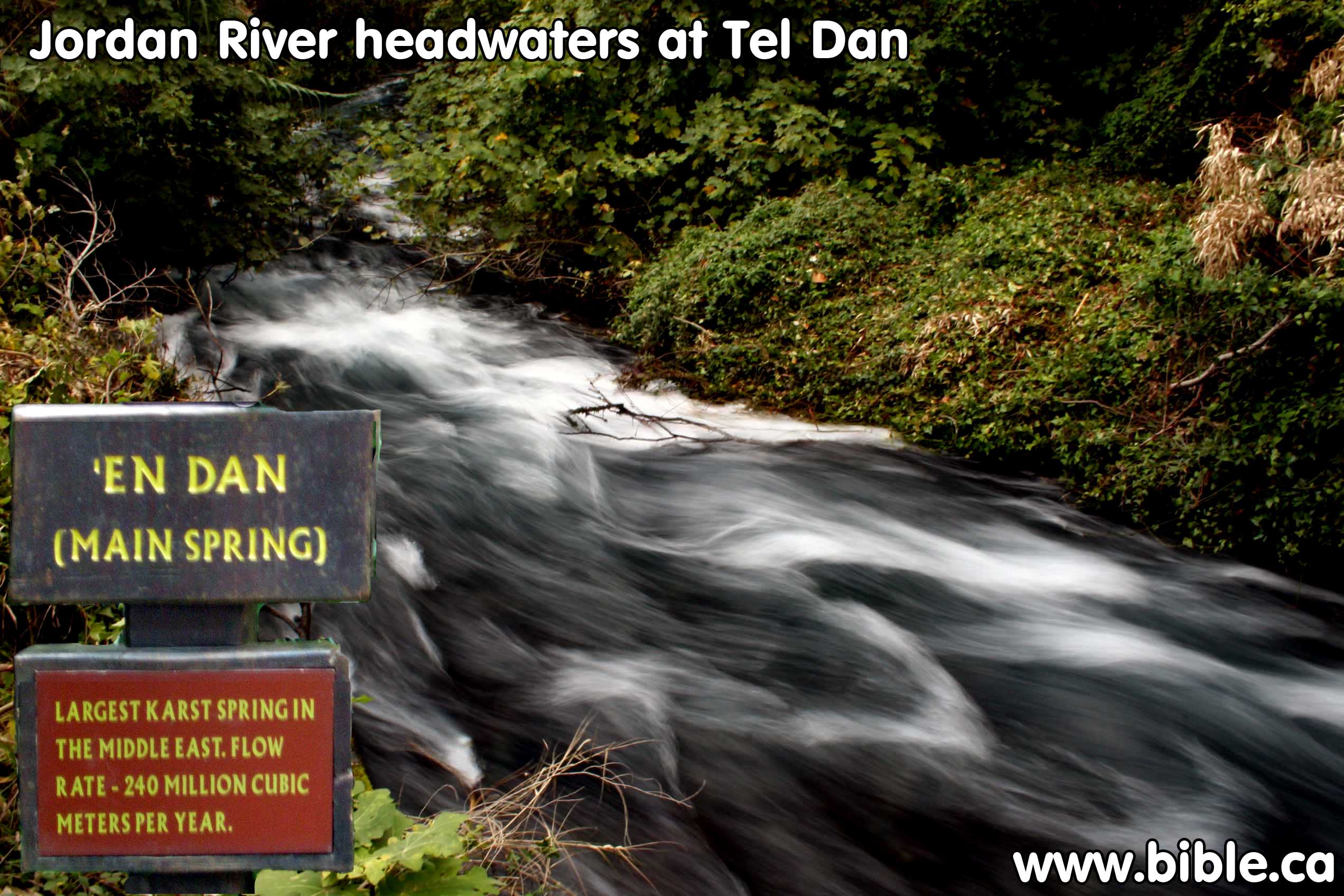The Jordan River and the Salt Sea: 1340 BC
Jordan = "Down from Dan"
Both Joshua parted the Jordan and crossed on dry ground.
Elijah/Elisha parted the Jordan and crossed on dry ground.
Naaman was cleansed of leprosy.
Place of John the Baptist and Jesus was baptized
See also:
Jeroboam's pagan temple at the headwaters of Tel Dan.
Introduction:
- The Jordan River is the primary water supply for Israel.
- Since the River derives its name from the tribe of Dan, it proves that the book of Genesis, Numbers and Deuteronomy were not written before the tribe of Dan migrated north to capture Laish in 1340 BC (Judges 18-19). The river was never named Jordan, until after the tribe of Dan occupied "Tel Dan". This is called the editorial practice in the proleptic use of placenames in the Bible. Here is a short list of proleptic names in the book of Genesis where a later name is applied to a location before it was ever called that name:
|
Original name when stories happened |
Later proleptic/anachronistic name inserted in earlier stories before the name existed in time |
|
Laish, Leshem: Renamed "Dan" by Tribe of Dan in 1304 BC in Judges 18:29; Josh 19:47 |
Dan used 2 times: Gen 14:14; Deut 34:1 |
|
Luz: Renamed "Bethel" by Jacob in Gen 28:19 between 2006 -1886 BC |
Bethel used 4 times: Genesis 12:8; 13:3 |
|
Zephath: Renamed Hormah by the tribes of Judah and Simeon in 1399 BC in Judges 1:17 |
Hormah used 5 times in Num 14:45; Deut 1:44; Josh 12:14; 15:30: 19:4 |
|
Mamre, Kiriath-Arba: Renamed Hebron possibly in 1094 BC, 7 years before Zoan was built in Egypt in 1087 BC. However, there is evidence and it is more likely that Zoan had been founded much earlier since Psalm 78:43 says that Zoan existed at the time of the Exodus in 1446 BC. But the Ps. Reference itself may be a proleptic name for Goshen since at the time of David and Ps 78, Zoan was the name used for the region of the eastern delta. The reference to Zoan in Num 13:22, on the other hand, may be a later editorial update. |
Hebron used 15 times in Genesis, Joshua and Judges: Gen 13:18; 23:19; 37:14; Num 13:22; Josh 10:3,5,23,36,39; 11:21; 12:10; 14:13; 21:13; Judges 1:20 |
|
Coins: darics of gold did not exist. Money began in about 400 BC. "for the service for the house of God they gave 5,000 talents and 10,000 darics of gold" |
Darics coins were first minted in the Persian period. Coins did not exist in Israel until the Perisan period. Since Chronicles was clearly written in the Persian period after the return from Babylon, the writer substituted the value of the weight of gold during the time of David for the equivalent in Persian Darics money. Two other references of these coins in the Persian period: Ezra 2:69; Neh 7:70 |
- The Jordan is a symbol that transcends thousands of years and many eras:
- Both Joshua parted the Jordan and crossed on dry ground: Joshua 3
- Elijah/Elisha parted the Jordan and crossed on dry ground: 2 Ki 2:8-14
- Naaman was cleansed of leprosy: 2 Ki 5
- Place of John the Baptist and Jesus was baptized: John 1:28
- Today we speak of crossing the Jordan as a symbol of physical death and entering into heaven with Jesus.
I. The actual Baptism Site of Jesus:
1. The place where Jesus was baptized was Bethany beyond the Jordan. “These things took place in Bethany beyond the Jordan, where John was baptizing. The next day he saw Jesus coming to him and said, “Behold, the Lamb of God who takes away the sin of the world!” (John 1:28-29)
2. Three are three baptism sites on the Jordan river:
a. Bethany beyond the Jordan: Jordanian side of Jordan river with Byzantine church 325 AD.
b. Bethany beyond the Jordan: Israeli side of Jordan river directly across from the Jordanian site opened in 2012 AD. This location is best because the Jordanian Government makes it difficult to get to the actual site. Tourists can be at the same side of the river, but in the safety, convenience and protection of the Israeli government and military.
c. With the New Baptism site located on safe and convenient Israeli soil, there is no need to visit this dirty, decrepit, dangerous and difficult to get to site in modern Jordan
d. Yardenit Baptism site at the south end of the sea of Galilee. (Convenient, safe tourist site)
3. Naaman was cleansed in the Jordan by dipping 7 times: 2 Ki 5
4. Elijah's/Elisha's parting of the Jordan:
a. “And it came about when the Lord was about to take up Elijah by a whirlwind to heaven, that Elijah went with Elisha from Gilgal. Elijah said to Elisha, “Stay here please, for the Lord has sent me as far as Bethel.” But Elisha said, “As the Lord lives and as you yourself live, I will not leave you.” So they went down to Bethel. Then the sons of the prophets who were at Bethel came out to Elisha and said to him, “Do you know that the Lord will take away your master from over you today?” And he said, “Yes, I know; be still.” Elijah said to him, “Elisha, please stay here, for the Lord has sent me to Jericho.” But he said, “As the Lord lives, and as you yourself live, I will not leave you.” So they came to Jericho. The sons of the prophets who were at Jericho approached Elisha and said to him, “Do you know that the Lord will take away your master from over you today?” And he answered, “Yes, I know; be still.” Then Elijah said to him, “Please stay here, for the Lord has sent me to the Jordan.” And he said, “As the Lord lives, and as you yourself live, I will not leave you.” So the two of them went on. Now fifty men of the sons of the prophets went and stood opposite them at a distance, while the two of them stood by the Jordan. Elijah took his mantle and folded it together and struck the waters, and they were divided here and there, so that the two of them crossed over on dry ground. When they had crossed over, Elijah said to Elisha, “Ask what I shall do for you before I am taken from you.” And Elisha said, “Please, let a double portion of your spirit be upon me.” He said, “You have asked a hard thing. Nevertheless, if you see me when I am taken from you, it shall be so for you; but if not, it shall not be so.” As they were going along and talking, behold, there appeared a chariot of fire and horses of fire which separated the two of them. And Elijah went up by a whirlwind to heaven. Elisha saw it and cried out, “My father, my father, the chariots of Israel and its horsemen!” And he saw Elijah no more. Then he took hold of his own clothes and tore them in two pieces. He also took up the mantle of Elijah that fell from him and returned and stood by the bank of the Jordan. He took the mantle of Elijah that fell from him and struck the waters and said, “Where is the Lord, the God of Elijah?” And when he also had struck the waters, they were divided here and there; and Elisha crossed over.” (2 Kings 2:1–14)
5. History of the Baptism site of Jesus being the same place of Joshua's crossing and Elijah's/Elisha's parting of the Jordan.
a. There is evidence that the place Jesus was baptized is the same place where Joshua parted the Jordan and Israel crossed into the promised land in 1406 BC and the same place that Elijah and Elisha parted the Jordan river.
b. This idea is derived from Origen of Alexandria (~225 AD) and the Syriac version of the Gospels (syrc, syrs) which translate the word "Bēth-abara" which is likely derived from the Heb bęt ʿabārâ, “house of crossing”.
c. "Because Origen could not find a location named Bethany on the E bank of the Jordan, he opted for the reading of Bēthabara in John 1:28, though almost all of the mss of his time read Bethany (Comm. on John 6. 24). Currently this reading is almost uniformly considered to be original because Bethany is not only extant in codices Vaticanus and Sinaiticus (4th century) but also in a large number of mss with considerable geographical distribution and because it is now possible to trace it back to the 3d century via P75, and as far back as to the 2d century via P66. Further, the transition from John 10:40–42 to 11:1ff. shows that the Evangelist intended the concordance with the name of the location Bethany near Jerusalem (11:1, 18). However, the agreement between Origen and the Syriac version of the Gospels (syrc, syrs) demonstrates that with Bēthabara he followed a genuine local tradition (Burkitt 1904:308–9, contra Clapp 1907:75–83). The name, likely derived from the Heb bęt ʿabārâ, “house of crossing,” points to one of the fords of the Jordan." (ABD, Bethany beyond the Jordan, 1992 AD)
6. The original writings of Origen of Alexandia: 225 AD:
a. “These things were done in Bethabara, beyond Jordan, where John was baptizing.” We are aware of the reading which is found in almost all the copies, “These things were done in Bethany.” This appears, moreover, to have been the reading at an earlier time; and in Heracleon we read “Bethany.” We are convinced, however, that we should not read “Bethany,” but “Bethabara.” We have visited the places to enquire as to the footsteps of Jesus and His disciples, and of the prophets. Now, Bethany, as the same evangelist tells us, was the town of Lazarus, and of Martha and Mary; it is fifteen stadia from Jerusalem, and the river Jordan is about a hundred and eighty stadia distant from it. Nor is there any other place of the same name in the neighbourhood of the Jordan, but they say that Bethabara is pointed out on the banks of the Jordan, and that John is said to have baptized there. The etymology of the name, too, corresponds with the baptism of him who made ready for the Lord a people prepared for Him; for it yields the meaning “House of preparation,” while Bethany means “House of obedience.” Where else was it fitting that he should baptize, who was sent as a messenger before the face of the Christ, to prepare His way before Him, but at the House of preparation?" (Origin, commentary on john Comm. John 6:24, 225 AD)
b. The story of Israel crossing Jordan under Joshua is typical of Christian things, and is written for our instruction… All this has been added, not, I conceive, without appropriateness, to our study of the baptism at the Jordan, administered by John at Bethabara." (Origin, commentary on john Comm. John 6:24, 225 AD)
c. "Of Elijah and Elisha crossing the Jordan… What enabled him to receive this gift of the spirit of Elijah was, perhaps, that he had passed through Jordan twice, once with Elijah, and the second time, when, after receiving the mantle of Elijah, he smote the water and said, “Where is the God of Elijah, even He? And he smote the waters, and they were divided hither and thither.” (Origin, commentary on john Comm. John 6:24, 225 AD)
7. It seems clear that the original text read Bethany not Bethabara as Origin imagined.
a. However Origin connected the baptism site of Bethabara with the modern baptism site on the Israeli side and the ancient byzantine site directly across the river from the Israeli site.
b. Origin's derived etymology of Beth-abara = "house of preparation", not "house of crossing".
c. Even if Origin is wrong that his translation of Beth-abara in John 1:28, he is still probably correct in his conclusion that the baptism of Jesus, the parting of the Jordan by Elijah and the crossing of the Jordan by Joshua all happened at this location.
8. The New Testament teaches that you are not saved until you are immersed in water for the remission of sins:
a. Naaman, the commander of Ben-Hadad II's army was cleansed of leprosy by dipping in the Jordan 7 times. This prefigures the purification of water baptism when we dip (immerse) once for the spiritual cleansing attained through the blood of Christ:
b. Water baptism saves you: Mk 16:16; 1 Peter 3:21
c. Water baptism is how you get born again imitating the death, burial and resurrection of Christ: John 3:3-5; Romans 6:3-7
d. Water baptism is for the forgiveness of sins: Acts 2:38; 22:16
e. Water baptism is the spiritual counterpart to Old Testament circumcision: Col 2:12-13
f. Water baptism is how we clothe ourselves with garments of salvation and Christ: Gal 3:26-27
g. No one in the Bible was ever baptized as an infant. Before a person can be baptized, they must believe, repent, confess etc. Acts 8:34-39; “As they went along the road they came to some water; and the eunuch said, “Look! Water! What prevents me from being baptized?” And Philip said, “If you believe with all your heart, you may.” And he answered and said, “I believe that Jesus Christ is the Son of God.” (Acts 8:36–37)
II. Yardenit Baptism site: Not the baptism site of Jesus.
1. Yardenit is a popular baptism site that attracts 500,000 tourists each year. White robes can be rented and handrails with stairs make baptism easy.
2. Yardenit is located at the place where the Jordan river leaves the southern tip of the Sea of Galilee and flows towards the Salt sea.
3. Otters and fish (Catfish and Saint Peter's Fish) swim freely in the river and the Sea of Galilee.
III. The headwaters of the Jordan River started at Tel Dan and Caesarea Philippi
|
Jordan = Jor + Dan = down from + Dan. Obviously the river was never called the Jordan until after Joshua died and Dan moved to Laish. At the foot of Mount Hermon, the Karst spring cave from which the Jordan River has its source is the largest in the Middle east with a yearly output of over 240 million cubic meters of water. It is absolutely pure, fast flowing and like a mountain stream, "makes your teeth crack" from being deliciously ice cold (15.5 degrees C). The headwaters of the Jordan start less than 100 meters from the pagan Danite temple which Jeroboam inherited from the grandson of Moses. |
- In Judges 18-19 we learn that the Danites transported the pagan shrine of Micah north to Laish in 1390 BC under the supervision of Jonathan, the grandson of Moses.
- “They called the name of the city Dan, after the name of Dan their father who was born in Israel; however, the name of the city formerly was Laish. The sons of Dan set up for themselves the graven image; and Jonathan, the son of Gershom, the son of Manasseh, he and his sons were priests to the tribe of the Danites until the day of the captivity of the land. So they set up for themselves Micah’s graven image which he had made, all the time that the house of God was at Shiloh.” (Judges 18:29-31)
- This pagan priestly dynasty of Jonathan and his sons, which traces itself back to Moses, lasted 617 years until the Assyrian captivity: 1340 - 723 BC.
- Like the Devil himself, the tribe of Dan was poison from the very beginning and like the waters of the Jordan that started with them, they made the rest of Israel drink their poisonous idolatry.
- The Devil always positions himself in a way so as to have the greatest negative effect on society.
- Teachers are the poisonous waters of humanism, evolution, immorality and Bible-hating atheism our children are forced to drink and we pay for it through our tax dollars.
- Just as the Devil likes to get as close as he can to the source, so too the most dangerous pagan temple in Israel was located about 100 meters from the source of the Jordan River.
- The result of Dan's idolatry is the ten northern tribes went into permanent exile, never to return.
- The tribe of Dan is NOT one of the 12 tribes in heaven as seen in the lists in the book of Revelation were Dan is lacking.
2. Josephus records how Philip carried out hydrologic tests to determine the source of the Jordan River.
a. Cleverly, Philip throw a bag of chaff into Philia lake (Berekhat Ram, Lake Ram) and it appeared some time later at Pania (Temple of Pan, Caesarea Philippi)
b. Philia lake (Ram Lake) is located 7 km east of Panias and is a round shallow sink hole (1000 x 600m) that has no water flowing out of it. It is about 2000 feet higher than Panias. It is fed by rainwater and a spring that is connected with the aquifer that feeds the Jordan River at Panias.
c. "Now Panium [Temple of Pan, Caesarea Philippi] is thought to be the fountain of Jordan, but in reality it is carried thither after an occult manner from the place called Phiala: (510) this place lies as you go up to Trachonitis, and is a hundred and twenty furlongs from Cesarea, and is not far out of the road on the right hand; (511) and indeed it hath its name of Phiala [vial or bow] very justly, from the roundness of its circumference, as being round like wheel; its water continues always up to its edges, without either sinking or running over; (512) and as this origin of Jordan was formerly not known, it was discovered so to be when Philip was tetrarch of Trachonitis; (513) for he had chaff thrown into Phiala, and it was found at Panium, where the ancients thought the fountainhead of the river was, whither it had been therefore carried [by the waters]. (514) As for Panium itself, its natural beauty had been improved by the royal liberality of Agrippa, and adorned at his expenses. (515) Now Jordan’s visible stream arises from this cavern, and divides the marshes and fens of the lake Semechonitis; when it hath run another hundred and twenty furlongs, it first passes by the city Julias, and then passes through the middle of the lake Gennesareth; after which it runs a long way over a desert, and then makes its exit into the lake Asphaltitis." (Josephus, Wars 3.509-515)
d.
It is important to realize that Philia lake (modern Lake Ram) is not the
source of water for the Jordan River, but is connected with the same aquifer as
the Jordan. The source of both the Jordan and Lake Ram is the aquifer from Lake
Hermon. Reports that the Israelis are draining the lake through their pumping
stations for the Jordan river 10 km away are absurd and untrue. Water output
from the springs of the Jordan and water levers in Philia lake are both
dependent upon Mt. Hermon rainfall and underwater sources. When the Jordan
River output is low, the water level in Ram Lake is low.

3. Here is the spring at Tel Dan and the outflow within the first 500 meters of the source. It is fast flowing, cold and pure.
4. Here is the spring at Panias (Temple of Pan, Caesarea Philippi) and the outflow within the first 500 meters of the source. It is fast flowing, cold and pure.
IV. Russians and Syria attempt to redirect the Jordan River to kill Israel
- Few westerners know about the true story of when the Russians tried to divert all the water from the Jordan river into Modern Jordan as an act of war.
- Thirteen Muslim states neighboring Israel realized that if they could divert the Jordan river to Syria and modern Jordan, Israel would die. After two summit meetings of the 13 Arab League Heads of State gathered in Cairo, 13-17 January 1964 construction began to divert the Hasbani river, Litani river and Banias river to the Yarmouk river.
- Backed primarily by Russian money, (with small token amounts from Saudi Arabia and Egypt) Syria, Lebanon and Jordan, started trenching the water canal along the slopes of the Golan toward the Yarmouk River.
- The result would divert 30 million cubic metres of water per year out of Israel's control, representing a grave national threat to survival.
- Israel considered it an act of war, retaliated and stopped the project dead through direct military action.
- Out of the goodness of its heart, Israel today shares the water with its Arab states, but retains control of the water guaranteeing peace in the Middle East. If the Arabs had succeeded in diverting the water, they would not share any with Israel.
- Ironically, "The Evil Empire" Russia, the financial backer of the water diversion plan, holds Poland and Lithuania hostage today over Natural Gas in order to gain political advantage ALL THE WHILE CHARGING HUGE PRICES FOR THE GAS. Today Israel shares the water free. God bless Israel!
- Russia holds Europe hostage over Natural Gas for its own selfish advantage. Israel altruistically holds the Arab nations hostage over water for world peace!
- Russia whose disastrous unpreparedness in building the 2014 Olympics on time to be ready for use, is unfit as a world player in nation building.
V. The Salt Sea (Dead Sea)
1. The Bible never calls the Salt Sea, THE DEAD SEA.
a. Sea of the Arabah: Deuteronomy 3:17
b. the valley of Siddim: Gen 14:3
c. East Sea: Ezek 47:13
d. The Romans called it Lake Asphaltitis (Lake of Asphalt)
2. Low annual rainfall in Israel combined with massive water redirection, the level of the Salt Sea is currently 50 meters (165 feet) below its level in 1900 AD.
3. The Ernest William Gurney "Masterman Rock" at Ein Feshkha [Fescha] by the Dead Sea is located about 3 km south of Qum'ran on highway 90. A compulsive scientist, Ernest immediately set about observing and recording the change. Starting in 1900 and then twice a year for the next thirteen years he carved a line on a rock at the water’s edge. Thus he literally made his mark on Palestine; and today you can see very clearly what he was observing and recording. Some twenty or thirty feet above the modern road along the shore of the Dead Sea you can still see Ernest’s first level of 1900, a horizontal line in the stone and the initials PEF.
Conclusion:
1. The Jordan River is central every aspect of life in Israel and the people who live there.
2. The blessings of the pure water of life start at Mount Hermon and end at the lowest point on earth at the Salt Sea where the waters are poison.
3. The Jordan River water system is unique in the entire world.
By Steve Rudd: Contact the author for comments, input or corrections.

